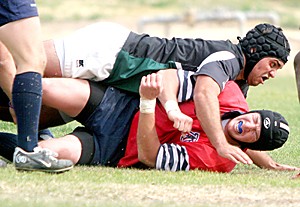The last game of the season for the Arizona club rugby team (7-6, 3-5 SoCal Conference) was destined to be a trial by fire. Down 15-7 against ASU (7-5, 4-4 SoCal Conference) in the first half March 25, the Wildcats needed to fight for every possession.
As junior flanker Chris Hintz tore down the field toward the Sun Devil ball carrier after a kickoff, there was only one thought in his mind.
“”Hit the other player as hard as possible to create a turnover,”” Hintz said. “”And if I injured him, that would have been a bonus.””
An injury was indeed the result of the brutal collision, but it wasn’t quite the bonus Hintz had imagined.
Moments after delivering a vicious blow, Hintz was down on the field, soon to be on his way to the hospital after suffering a severe trauma to his trachea.
“”Getting taken off the field in such a big game was the last thing I could have expected,”” Hintz said. “”I had to spend four days in the hospital, but thankfully I don’t remember most of it.””
Injuries in rugby are not uncommon. But in a full-contact sport where the players have no protection to speak of, and there are from 10 to 15 players with injuries at any given time during the season, the question arises: is the sport too dangerous?
Arizona rugby head coach Dave Sitton’s answer is an emphatic “”no.””
“”There are fewer injuries (in rugby) and they are less severe on average than in American football,”” Sitton said. “”I’ve never seen a trachea trauma like that in 28 years of coaching.””
He also maintains that rugby’s lack of equipment and different rules add to its safety.
“”The (American) football helmet is not only used to block, but it’s also used to tackle just as often. With the helmet, the odds of injury increase exponentially,”” Sitton said. “”In addition, rugby has no first downs, so we aren’t trying to knock them backwards in order to make it third and long.””
“”And because the only possible blocker is near the ball carrier, frequency of contact is minuscule,”” he added.
Despite Sitton’s belief that rugby is less violent than football, 10 to 15 injuries per game, however minor, can add up in trainers’ fees, first aid equipment and medical costs.
Senior associate athletic director Kathleen “”Rocky”” LaRose recognized that “”insurance policies are a huge cost”” for varsity sports, and the athletic department is “”worried about the future of adding high-risk activities.””
LaRose did say, however, that such fears do not influence rugby’s stock toward becoming a Division I varsity sport. The bigger issues center around Title IX considerations, she said.
And despite the risk of injury, a consideration that is present when playing any full contact sport, Hintz and other club sport athletes like him remain undaunted. To them, it just comes with the territory.
“”I still think (rugby) is one of the toughest sports anyone can play,”” Hintz said. “”In my rookie season, I dislocated my shoulder twice and broke my nose and hand once, but if you’re worried about getting hurt, you’re not going to be playing at your best.””
Weeks after the fateful tackle, Hintz is nearly back to full strength.
“”My trachea is healing fine,”” he said. “”It’s been almost a month and my voice is almost completely back to normal.””
Most importantly for the third-year Rugger, “”It won’t affect me for playing next season.””
It’s hard to imagine anything that would.









